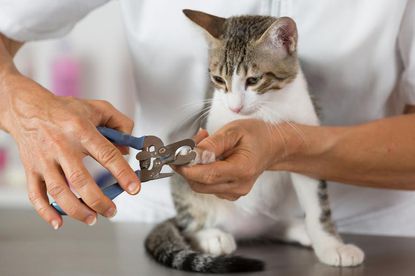“In addition to the long term medical complications of declawing, there are also common behavior complications.”
![]()

Photo courtesy humanrescue.org
By Dr. Jeanne Haggerty-Arcay

Dr. Jeanne Haggerty-Arcay
Excessive scratching, particularly at furniture, is a common complaint from many cat owners. As young kittens, the normal behavior is “cute.” But as the kitten grows, they begin to use the scratching to help shed the outer layers of their nails and stretch out their limbs and back. If not given appropriate scratching posts and encouraged to use these scratching posts as young kittens, they will often find other places to scratch . . . often a couch or chair. This behavior can be very destructive, costly and a point of contention in kitty households. For some owners, it can be more serious, especially those with bleeding disorders or compromised immune systems.
Declawing in cats was once a commonly requested procedure to serve as a “quick fix” for the often normal behavior. In most cases, cat owners did not really understand what the procedure really entails.
Declawing is far more than a nail trim, it is actually a surgical amputation of the last bone in each toe and typically performed on both front feet. The feet are then bandaged and pain medication is provided. The human equivalent would be amputation of the fingers at the first knuckle. As you may imagine, amputating the tip of each toe is an extremely painful procedure. These cats are in pain after surgery and the pain may last much longer than previously thought. Many of these cats will show pain well after the incisions appear to be healed and may be limping for long periods of time due to pain. An alternative to the amputation is a tendonectomy, which involves severing the tendon that controls the nail in each toe. This prevents the cat from being able to extend their nail to scratch but can lead to long term complications involving abnormal nail growth that can worsen the snagging of nails and make trimming the nails difficult.
 In addition to the long term medical complications of declawing, there are also common behavior complications. Many declawed cats become biters. Biting presents a far bigger problem for owners, as cat bites can result in severe infections and are more likely to spread disease than scratches. Some cats will also permanently lose their loving personality, thought to result from some degree of chronic pain associated with the procedure. In other cases, the cat will start inappropriate elimination and refuse to use the litter box on a consistent basis as they have pain in their feet when scratching in the box. These are all very difficult behaviors to resolve and often cause friction within households.
In addition to the long term medical complications of declawing, there are also common behavior complications. Many declawed cats become biters. Biting presents a far bigger problem for owners, as cat bites can result in severe infections and are more likely to spread disease than scratches. Some cats will also permanently lose their loving personality, thought to result from some degree of chronic pain associated with the procedure. In other cases, the cat will start inappropriate elimination and refuse to use the litter box on a consistent basis as they have pain in their feet when scratching in the box. These are all very difficult behaviors to resolve and often cause friction within households.
 In more recent years, laws regulating the procedure have started to crop up in various regions of the U.S. and declawing has been banned altogether in some countries. The California Veterinary Medical Association recently put out a statement just short of banning the procedure. They provided very specific guidelines under which the procedure may be indicated. Declawing is strongly discouraged “except for medically necessary reasons or when scratching presents a health risk to the owner . . . declawing should not be performed unless all other alternatives have been explored and attempted and only following extensive client education.” There are few remaining hospitals that will perform the procedure in the region.
In more recent years, laws regulating the procedure have started to crop up in various regions of the U.S. and declawing has been banned altogether in some countries. The California Veterinary Medical Association recently put out a statement just short of banning the procedure. They provided very specific guidelines under which the procedure may be indicated. Declawing is strongly discouraged “except for medically necessary reasons or when scratching presents a health risk to the owner . . . declawing should not be performed unless all other alternatives have been explored and attempted and only following extensive client education.” There are few remaining hospitals that will perform the procedure in the region.
So what should a cat owner do about scratching in the home?
Keep claws trimmed short and trim often so your cat becomes acclimated to having the nails trimmed at home.
Provide adequate scratching posts and boards to provide alternatives to scratching on your furniture.
Soft paws — These are plastic caps that are glued onto each nail and will help prevent snagging. These do have to be replaced on regular intervals, typically every six to eight weeks.
Deterrents — Sticky tape can be applied to furniture and other surfaces as a humane deterrent.
Avoid Tweed — When purchasing furniture, avoid tweed and other fabrics in which claws can easily snag their nails.






